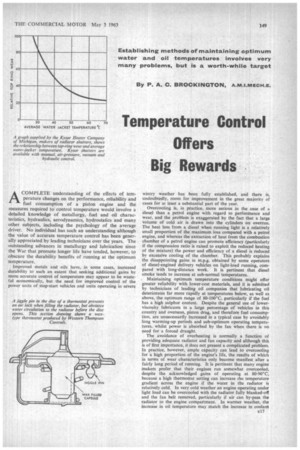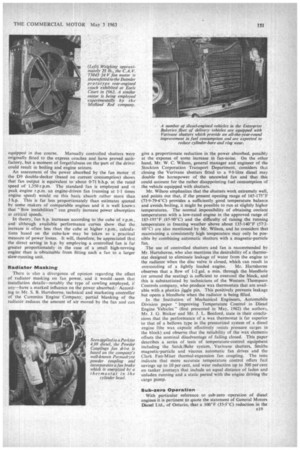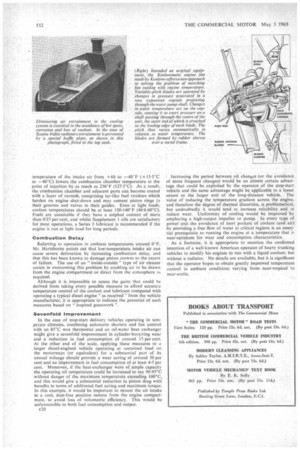Temperature Control Offers Big Rewards
Page 151

Page 152

Page 153

Page 154

If you've noticed an error in this article please click here to report it so we can fix it.
ACOMPLETE understanding of the effects of temperature changes on the performance, reliability and fuel consumption of a piston engine and the measures required to control temperature would involve a detailed knowledge of metallurgy, fuel and oil characteristics, hydraulics, aerodynamics, hydrostatics and many other subjects, including the psychology of the average
driver. No individual has such an understanding although the value of accurate temperature control has been gener ally appreciated by leading technicians over the years. The outstanding advances in metallurgy and lubrication since the War that promote longer life have tended, however, to obscure the durability benefits of running at the optimum temperature.
Improved metals and oils have, in some cases, increased durability to such an extent that seeking additional gains by more accurate control of temperature may appear to be wasteful economically, but the need for improved control of the power units of stop-start vehicles and units operating in severe wintry weather has been fully established, and there is, undoubtedly, room for improvement in the great majority of cases for at least a substantial part of the year.
Overcooling is, in practice, more serious in the case of a diesel than a petrol engine with regard to performance and wear, and the problem is exaggerated by the fact that a large volume of cold air is drawn into the cylinders on overrun. The heat loss from a diesel when running light is a relatively small proportion of the maximum loss compared with a petrol engine, and whereas the extraction of heat from the combustion chamber of a petrol engine can promote efficiency (particularly if the compression ratio is raised to exploit the reduced heating of the mixture) the power and efficiency of a diesel is reduced by excessive cooling of the chamber. This probably explains the disappointing gains in m.p.g. obtained by some operators of diesel-engined delivery vehicles on light-load running, compared with long-distance work. It is pertinent that diesel smoke tends to increase at sub-normal temperatures.
Maintaining optimum temperature conditions might offer greater reliability with lower-cost materials, and it is admitted by technicians of leading oil companies that lubricating oil deteriorates far more rapidly at temperatures below, as well as above, the optimum range of 80-100*C, particularly if the fuel has a high sulphur content. Despite the general use of lowerviscosity lubricants in a large percentage of vehicles in this country and overseas, piston drag, and therefore fuel consumption, are unnecessarily increased in a typical case by avoidably long warming-up periods and sub-optimum operating temperatures. whilst power is absorbed by the fan when there is no need for a forced draught.
The avoidance of overheating is normally a function of providing adequate radiator and fan capacity and although this is of first importance, it does not present a complicated problem. In practice, however, ample capacity can lead to overcooling for a high proportion of the engine's life, the results of which in terms of wear characteristics only become manifest after a fairly long period of running. It is pertinent that many engine makers prefer that their engines run somewhat overcooled, despite the acknowledged gains of operating at 80-90°C, because a high thermostat setting can increase the temperature gradient across the engine if the water in the radiator is relatively cold. In very cold weather an engine operating under light load can be overcooled with the radiator fully blanked-off and the fan belt removed, particularly if air can by-pass the radiator to the engine compartment. In warmer weather, the increase in oil temperature may match the increase in coolant .emperature in a typical case, but in colder weather there is a tendency (depending on the exposed area of the sump) for oiltemperature increase to lag behind the rise in coolant temperature. In very hot climates an oil-water heat exchanger may be needed to prevent oxidation of the oil and the formation ot hot sludge, but there is probably an even greater need for a heat-exchanger in cold and temperate climates to give rapid warming up and to maintain a near-optimum temperature to reduce oil drag on the pistons and prevent the formation of cold sludge Engine Wear Accelerated wear in a cold engine is, in every case, a function of corrosive attack on bores, rings and pistons, and sometimes bearings and other working parts, by the acidic products of combustion (notably sulphuric acid) which are vaporized at higher temperatures. The acids may attack the working parts direct or as an absorbed element of the lubricating oil. Heavy acidic attack can be counteracted to some extent by employing • a suitable additive-treated oil, hut this is costly and in any ease it necessitates more frequent oil changes.
In the opinion of some scientists, an engine would run indefinitely without wear, apart from that caused by acidic attack, if the air were completely filtered and combustion debris could be eliminated. As shown by Hepworth and Grandage tests of engines fitted to diesel-engined light-delivery vehicles, frequent stops and starts can increase piston groove and topring wear by more than 500 per cent if an unmodified cooling system is employed, compared with identical engines engaged on longer runs and garaged in heated depots. The small diesel engine in this case has a normal life between major overhauls of about 100,000 miles, and in one or more of the many cases investigated ring or land collapse was occurring at less than 20,000 miles.
If an operator is obtaining upwards of 200,000 miles from a larger engine before a major overhaul is required, there would appear to be little advantage to be gained from more accurate control of temperature. but the results of a 24-year test by the Midland Red company of a double-decker on stage-carriage work indicate that it can, in practice, yield a substantial benefit. The bus was equipped with Varivane shutters after it had covered 50,000 miles, and its total mileage is now 185,000. Oi' consumption is about 1,200 m.p.g., whereas the normal consumption of a similar bus on the same routes is approximately 600-700 m.p g., and it is assumed that the difference in wear rates is comparable. Although no gain in fuel consumption has been recorded, the possibility of some improvement is not ruled out, and the system offers the immediate advantage
e18 of more efficient saloon heating. This advantage has been reiterated by a number of undertakings. '
Other experimental work of the Midland • Red company includes the use of an electrically driven fan with a C.A.V. motor in conjunction with Varivane shutters on a D9 doubledecker, the cut-in switch of the fan motor being operated by the wax thermostat of the shutter equipment during the final opening phase. A continuous recorder has been employed to obtain the length of time the fan is operative and inoperative on various runs and the tests have produced valuable data. They show that whilst the fan is rarely required in an ambient temperature of 49-53°F (9.4-11-6C) the availability of a forced
draught is essential when running in dense traffic. During one hour of a run to a football match, for example, the fan was operating for 21 min.. whilst the overall operating period in the day's running time of 650 min. was 45 min.
The 10.5-litre naturally aspirated engine of a CM6 36-ft. motorways coach is fitted with Varivane shutters and the 8'1-litre power units of 27 CM5 30-ft. coaches will.be similarly equipped in due course. Manually controlled shutters were originally fitted to the express coaches and have proved satisfactory, but a moment of forgetfulness on the part of the driver could result in boiling and engine seizure.
Art assessment of the power absorbed by the fan motor 3f the D9 double-decker (based on current consumption) shows that fan output is equivalent to about 0-71 b.h.p, at the rated speed of 1,350 r.p.m. The standard fan is employed and ttt peak engine r.p.m. an engine-driven fan (running at 1-1 times engine speed) would on this basis absorb rather more than 3 h.p. This is far less proportionately than estimates quoted by some makers of comparable engines and it is well known that "flow instabilities" can greatly increase power absorption at critical speeds.
In theory, fan h.p. increases according to the cube of r.p.m and although available performance curves show that the increase is often less than the cube at higher r.p.m.. calculations based on the cube-law may be taken as a practical measure of power losses. It will, therefore, be appreciated that the direct saving in h.p. by employing a controlled fan is far greater proportionately in the case of a small high-revving engine than is -obtainable from fitting such a fan to a larger slow-running unit.
Radiator Masking
There is also a divergence a opinion regarding the effect of radiator masking on fan power, and it would ,seem that installation details—notably the type of cowling employed, if any—have a marked influence on the power absorbed. According to Mr. S. B. Hartshorne. technical and marketing controller of the Cummins Engine Company, partial blanking of the radiator reduces the amount of air moved by the fan and can
give a proportionate reduction in the power absorbed, possibly at the expense of some increase in fan-noise. On the other hand. Mr. W. C. Wilson, general manager and engineer of the Stockton Corporation Transport Department, considers that closing the Varivane shutters fitted to a 9-8-litre diesel may double the horsepower of the uneowled fan and that this could account for the rather disappointing fuel consumption of the vehicle equipped with shutters.
Mr. Wilson emphasizes that the shutters work extremely well, and points out that, if the present opening range of 165-175°F (73.9-79.4°C) provides a sufficiently good temperature balance and avoids boiling, it might be possible to run at slightly higher temperatures. The normal impossibility of obtaining coolant temperatures with a low-rated engine in the approved range of I85-195°F (85-90°C) and the difficulty of raising the running temperature in freezing weather above about 135-140°F (57-260°C} are also mentioned by Mr. Wilson, and he considers that maintaining a consistently high temperature may only be possible by combining automatic shutters with a magnetic-particle fan.
The use of controlled shutters and fan is recommended by Mr. Hartshorne, who also mentions the desirability of a thermostat designed to eliminate leakage of water from the engine to the radiator when the disc valve is closed, which can result in overcooling of ,a lightly loaded engine. Mr. Hartshorne observes that a flow of 1-2 gal. a mm. through the bleedhole (or around the seating) is sufficient to overcool the block, and this is substantiated by technicians of the Western Thompson Controls company, who produce wax thermostats that are available with a plastics jiggle pin. This positively prevents leakage but opens a bleedhole when the radiator is being filled.
In the Institution of Mechanical Engineers, Automobile Division paper "Improving Temperature Control in Diesel Engine Vehicles' (first presented in May, 1962) the authori, Mr. J. G. Bisiker and Mr. J. L. Benford, state in their conclusions that the performance of a wax thermostat is far superior to that of a bellows type in the pressurized system of a diesel engine (the wax capsule effectively resists pressure surges in the block) and observe that the reliability of the wax elements offsets the nominal disadvantage of failing closed. This paper describes a series of tests of temperature-control equipment including the Serck/Behr system, Varivane shutters, Smiths magnetic-particle and viscous automatic fan drives and the Clark Fan-Miser thermal-expansion fan coupling. The tests indicate that more accurate temperature control offers fuel savings up to 10 per cent, and wear reduction up to 300 per cent on tanker journeys that include an equal distance of laden and unladen running and a static period with the engine driving the cargo pump.
Sub-zero Operation
With particular reference to sub-zero operation of diesel engines it is pertinent to quote the statement of General Motors Diesel Ltd., of Ontario, that a 100°F (55•5°C) reduction in the a 1 9
temperature of the intake air from +60 to —40°F (+15-5°C to —40°C) lowers the combustion chamber temperature at the point of injection by as much as 230°F (127-3°C). ,As a result, the combustion chamber and adjacent parts can become coated with a layer of varnish, comprising tar-like fuel residues which harden on engine shut-down and may cement piston rings in their grooves and valves in their guides. Even at light loads, coolant temperatures should be at least 120-140°F (48-8-60°C). Fuels are unsuitable if they have a sulphur content of more than 0.25 per cent, and whilst Supplement I oils are satisfactory for most operations, a Series 3 lubricant is recommended if the engine is run at light load for long periods.
Combustion Delay
Referring to operation in ambient temperatures around 0°F, Mr. Hartshorne points out that low-temperature intake air can cause severe detonation by increasing combustion delay, and that this has been known to damage piston crowns to the extent of failure. The use of an "inside-outside" type of air cleaner assists in overcoming this problem by enabling air to be drawn from the engine compartment or direct from the atmosphere is required.
Although it is impossible to assess the gains that could he derived from taking every possible measure to afford accurate temperature control of the coolant and lubricant compared with operating a typical diesel engine "as received" from the vehicle manufacturer, it is appropriate to indicate the potential of such measures based on `.4 inspired guesswork ".
Sevenfold Improvement
In the case of stop-start delivery vehicles operating in temperate climates, combining automatic shutters and fan control with an 85°C wax thermostat and an oil-water heat exchanger might give a sevenfold improvement in cylinder-bore/ring wear and a reduction in fuel consumption of around 15 per cent. At the other end of the scale, applying these measures to a larger diesel-engined vehicle operating at sustained load on the motorways (or equivalent) for a substantial part of its annual mileage should provide a wear saving of around 50 per cent and an improvement in fuel consumption of at least 4-5 per cent. Moreover, if the heat-exchanger were of ample capacity the operating oil temperature could be increased to say 90-95°C without danger of the maximum temperature exceeding 100°C,, and this would give a substantial reduction in piston drag with benefits in terms of additional fuel saving and maximum torque. In this example, it would be important to mount the air intake in a cool, dust-free position remote from the engine compartment, to avoid loss of volumetric efficiency. This would be unfavourable to both fuel consumption and output.
a20 Increasing the period between oil changes (or the avoidance of more frequent changes) would be an almost certain advantage that could be exploited by the operator of the stop-start vehicle and the same advantage might be applicable to a lesser extent to the larger unit of the long-distance vehicle. The value of reducing the temperature gradient across the engine, and therefore the degree of thermal distortion, is problematical, but undoubtedly it would tend to increase reliability and to reduce wear. Uniformity of cooling would be improved by employing a high-output impeller or pump. In every type of power unit the avoidance of inert pockets of eciolant (and air) by providing a free flow of water in critical regions is an essential prerequisite to running the engine at a temperature that is near-optimum for wear and consumption characteristics.
As a footnote, it is appropriate to mention the confirmed intention of a well-known American operator of heavy trunking vehicles to modify his engines to run with a liquid coolant; but without a radiator. No details are available, but it is significant that the operator hopes to obtain greatly improved temperature control in ambient conditions varying from near-tropical to near-arctic,




















































































































































































































































